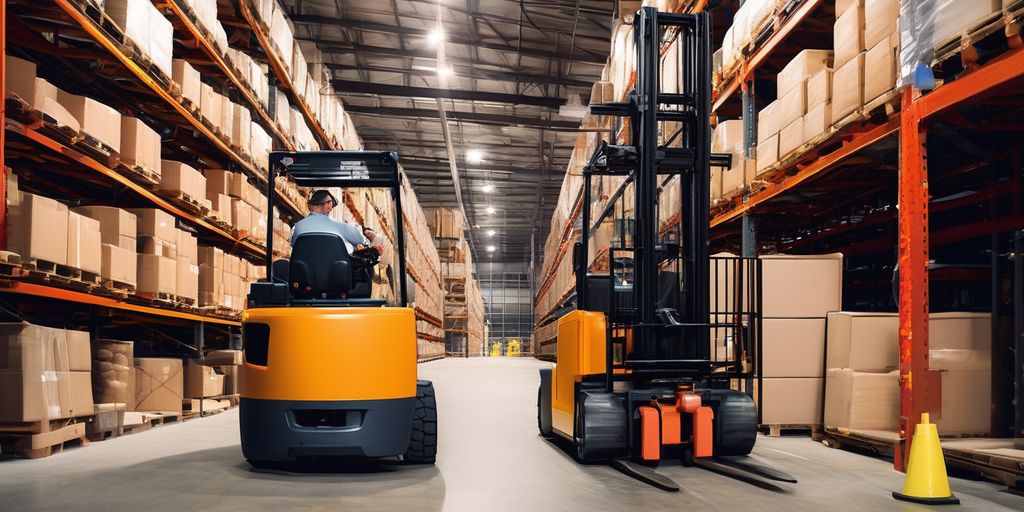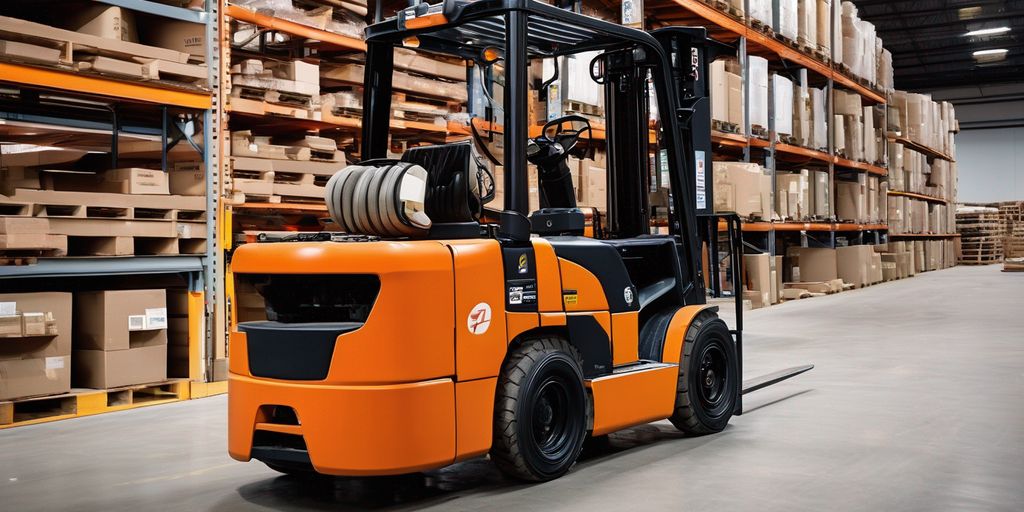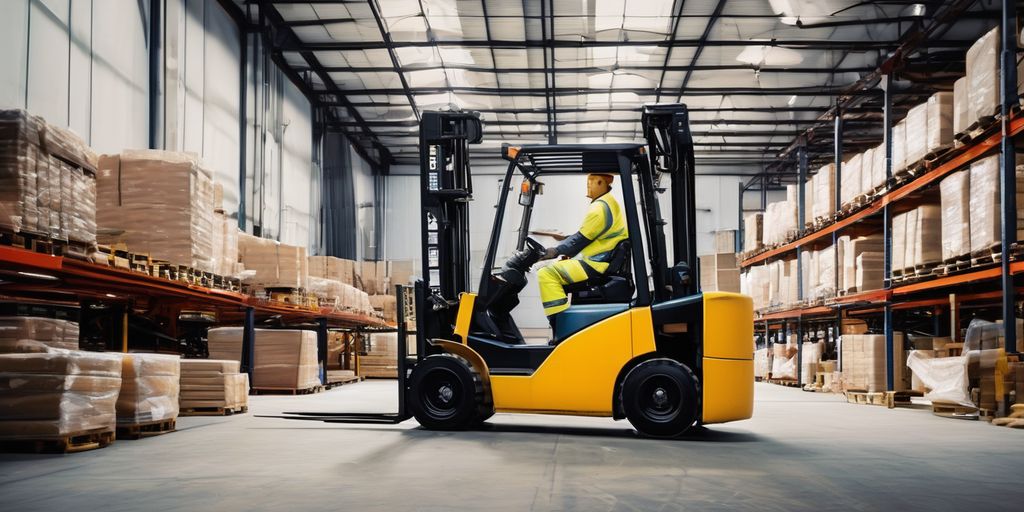Capacitación en seguridad de montacargas: protección de su fuerza laboral y sus operaciones — overview
La capacitación en seguridad de montacargas mejora la seguridad en el lugar de trabajo al brindarles a los operadores conocimientos y habilidades integrales para operar montacargas de manera segura, reduciendo el riesgo de accidentes, lesiones y daños a la propiedad. El curso de capacitación en seguridad también garantiza el cumplimiento de las normas reglamentarias, ya que OSHA exige capacitación formal para los operadores de montacargas. Cumplir con estos estándares no sólo evita sanciones legales sino que también fomenta una cultura de seguridad en el lugar de trabajo.
Conclusiones clave
- La formación en seguridad con montacargas reduce significativamente el riesgo de accidentes y lesiones en el lugar de trabajo.
- El cumplimiento de las regulaciones de OSHA es obligatorio para los operadores de montacargas y ayuda a evitar sanciones legales.
- Los programas de capacitación efectivos incluyen un plan de estudios integral, práctica práctica y evaluación para la certificación.
- La implementación de medidas de seguridad, como la creación de zonas de trabajo seguras y las inspecciones periódicas de los equipos, mejora la seguridad en el lugar de trabajo.
- Las técnicas de capacitación avanzadas, como las simulaciones de realidad virtual y los programas de educación continua, mejoran las habilidades del operador y la conciencia de seguridad.
Comprender la importancia de la capacitación en seguridad de montacargas
La capacitación en seguridad de montacargas mejora la seguridad en el lugar de trabajo al brindarles a los operadores conocimientos y habilidades integrales para operar montacargas de manera segura, lo que reduce el riesgo de accidentes, lesiones y daños a la propiedad. El curso de capacitación en seguridad también garantiza el cumplimiento de las normas reglamentarias, ya que OSHA exige capacitación formal para los operadores de montacargas. Cumplir con estas normas no solo evita sanciones legales , sino que también fomenta una cultura de seguridad en el lugar de trabajo.
Componentes clave de una formación eficaz en seguridad de montacargas
Plan de estudios integral
Un plan de estudios completo es esencial para una formación eficaz en seguridad de las carretillas elevadoras. Debe abarcar todos los aspectos de su uso, incluidos los protocolos de seguridad, los procedimientos de mantenimiento y la respuesta ante emergencias. Esto garantiza que los operadores estén bien versados tanto en los aspectos teóricos como prácticos del uso de las carretillas elevadoras.
Práctica Práctica
La práctica es fundamental para que los operadores adquieran experiencia en un entorno controlado. Las sesiones prácticas permiten a los operadores aplicar lo aprendido en situaciones del mundo real, lo que ayuda a consolidar sus habilidades y conocimientos. Este enfoque no solo mejora la competencia del operador, sino que también aumenta la confianza en el manejo seguro de las carretillas elevadoras.
Evaluación y Certificación
La evaluación y la certificación son componentes vitales de cualquier programa de capacitación en montacargas. Los operadores deben ser evaluados para garantizar que dominan las habilidades y conocimientos necesarios. La certificación sirve como prueba de su competencia y, a menudo, es necesaria para cumplir con las normas reglamentarias. Los empleadores deben mantener registros detallados de toda la capacitación sobre montacargas realizada, incluidas las fechas de certificación y las materias que se impartieron.
Una lista de verificación de capacitación en montacargas es un documento o herramienta estructurada que describe los componentes clave necesarios para llevar a cabo una capacitación efectiva en seguridad de montacargas.
Regulaciones y Cumplimiento de OSHA
Requisitos de Capacitación Obligatoria
La misión de la OSHA es clara: prevenir lesiones, enfermedades y muertes relacionadas con el trabajo mediante la emisión de normas sobre todo, desde el funcionamiento de montacargas hasta las salidas de emergencia. Los empleadores son responsables de proporcionar un entorno de trabajo seguro que cumpla con las normas de la OSHA. Esto incluye realizar inspecciones periódicas, brindar capacitación de seguridad esencial a los empleados y corregir cualquier peligro identificado de inmediato.
Evitando Sanciones Legales
El incumplimiento de las normas de OSHA puede dar lugar a multas y sanciones importantes. Garantizar el cumplimiento de las normas de OSHA es fundamental para proteger a los empleados y clientes de posibles peligros.
Mantenimiento de la Cumplimiento
La Administración de Salud y Seguridad Ocupacional, conocida como OSHA, desempeña un papel crucial para garantizar la seguridad en el lugar de trabajo en todo Estados Unidos. Creada por el Congreso en virtud de la Ley de Salud y Seguridad Ocupacional de 1970, esta agencia establece y hace cumplir normas protectoras de seguridad y salud en el lugar de trabajo.
Comprender las regulaciones de OSHA para las operaciones de montacargas es esencial para mantener un lugar de trabajo seguro y que cumpla con las normas.
Implementación de medidas de seguridad en el lugar de trabajo
Creando Zonas de Trabajo Seguras
Es fundamental crear carriles designados para separar el tráfico de montacargas y peatones. Las barreras y señales de advertencia deben colocarse estratégicamente para mejorar la seguridad. La concienciación sobre las situaciones peligrosas en el lugar de trabajo es fundamental para prevenir accidentes.
Inspecciones Regulares de Equipos
Es imprescindible realizar inspecciones diarias de los equipos . Esto garantiza que cualquier problema potencial se identifique y se solucione rápidamente, lo que reduce el riesgo de accidentes. Las inspecciones periódicas también ayudan a gestionar eficazmente los costos de mantenimiento de las carretillas elevadoras .
Preparación para emergencias
La planificación y la preparación para evitar situaciones peligrosas son vitales. Los empleados deben recibir capacitación sobre los procedimientos de emergencia y el uso de equipos de seguridad. Debe existir un sistema de comunicación transparente para garantizar que todos conozcan los protocolos de seguridad.
Haga cumplir las políticas de seguridad en cada oportunidad para proteger a su personal de incidentes con montacargas. Asegúrese de que los empleados conozcan las consecuencias de violar las pautas y reglas de seguridad.
Beneficios de la capacitación en seguridad de montacargas para empleadores
Reducción de Costos Operativos
Invertir en capacitación en seguridad para montacargas puede reducir significativamente los costos operativos. Al minimizar los accidentes y los daños a los equipos, las empresas pueden ahorrar en gastos de reparación y reemplazo. Además, operadores debidamente capacitados son más eficientes, lo que se traduce en un menor consumo de combustible y menores costos de mantenimiento.
Mejorando la Moral de los Empleados
Un entorno de trabajo seguro aumenta la moral de los empleados. Cuando los trabajadores se sienten seguros, es más probable que estén satisfechos con su trabajo y permanezcan leales a la empresa. Esto puede conducir a tasas de rotación más bajas y una mayor productividad.
Mejorando la Productividad
Una formación adecuada en el uso de carretillas elevadoras no solo permite contar con lugares de trabajo más seguros, sino que también aumenta la productividad. Cuando se les capacita para operar carretillas elevadoras de manera eficiente, pueden mover materiales con mayor rapidez y precisión, lo que maximiza la eficiencia en la gestión de la flota de carretillas elevadoras mediante la capacitación de los operadores, el mantenimiento programado, la optimización del diseño de las instalaciones y las estrategias de ahorro de costos.
Una fuerza laboral bien capacitada es una fuerza laboral productiva. Invertir en formación en seguridad es una inversión en el futuro de su empresa.
Técnicas Avanzadas de Entrenamiento
Simulaciones de Realidad Virtual
Las simulaciones de realidad virtual (RV) ofrecen un enfoque de vanguardia para la capacitación en seguridad de montacargas. Estas simulaciones brindan un entorno realista e inmersivo donde los operadores pueden practicar el manejo de diversas situaciones sin el riesgo de consecuencias en el mundo real. Al combinar una capacitación exhaustiva, el cumplimiento de las pautas de OSHA y la integración de soluciones de seguridad avanzadas, se puede mejorar significativamente la seguridad de los montacargas.
Módulos de Aprendizaje Interactivo
Los módulos de aprendizaje interactivos están diseñados para involucrar a los operadores a través de contenido multimedia, cuestionarios y comentarios en tiempo real. Se puede acceder a estos módulos en línea, lo que permite horarios de aprendizaje flexibles. Son particularmente eficaces para reforzar los conocimientos teóricos y garantizar que los operadores comprendan la importancia de la capacitación sobre montacargas para la prevención de accidentes .
Programas de Educación Continua
Los programas de educación continua garantizan que los operadores de montacargas se mantengan actualizados con las últimas prácticas y regulaciones de seguridad. Estos programas a menudo incluyen cursos de actualización periódicos y técnicas de capacitación avanzadas para mantener las habilidades actualizadas y los conocimientos actualizados. Los empleadores pueden beneficiarse de estos programas manteniendo un alto nivel de seguridad y cumplimiento en sus operaciones.
Invertir en técnicas de formación avanzadas no sólo mejora las habilidades de los operadores sino que también fomenta una cultura de seguridad en el lugar de trabajo.
Funciones y responsabilidades en la seguridad de los montacargas

Los empleadores desempeñan un papel fundamental a la hora de garantizar la seguridad de las carretillas elevadoras. Deben ofrecer programas de formación integrales y asegurarse de que todos los operadores estén certificados y sean competentes . Además, los empleadores deben mantener registros detallados de todas las sesiones de formación, incluidas las fechas de certificación y los temas tratados. Se debe realizar una formación de seguridad periódica para todos los empleados que trabajan cerca de carretillas elevadoras para garantizar que todos conozcan los protocolos de seguridad.
Los operadores de montacargas son responsables de operar de manera segura los montacargas para mover materiales, cargar y descargar camiones, apilar palés y realizar otras tareas en los almacenes. Deben realizar inspecciones de rutina y reparar cualquier problema menor en los montacargas, verificando si hay signos de desgaste. Los operadores también deben comprender las tareas básicas de mantenimiento para mantener el montacargas en óptimas condiciones de funcionamiento y seguir los protocolos de seguridad para cargar combustible, reabastecerlo y manipular baterías.
Los gerentes de seguridad supervisan la implementación de medidas de seguridad y garantizan el cumplimiento de los estándares de la industria. Son responsables de crear zonas de trabajo seguras, realizar inspecciones periódicas de equipos y prepararse para emergencias. Los gerentes de seguridad también deben garantizar que se sigan todos los protocolos de seguridad y que cualquier incidente se investigue minuciosamente para evitar incidentes futuros.
Conclusión
La capacitación en seguridad de montacargas es un componente esencial para garantizar la seguridad y eficiencia de sus operaciones. Al equipar a los operadores con los conocimientos y habilidades necesarios, se reduce significativamente el riesgo de accidentes, lesiones y daños a la propiedad. El cumplimiento de las normas reglamentarias de OSHA no sólo ayuda a evitar sanciones legales sino que también promueve una cultura de seguridad en el lugar de trabajo. Invertir en programas integrales de capacitación para todas las personas involucradas en las operaciones de montacargas, desde operadores hasta supervisores, fomenta un ambiente de trabajo más seguro y productivo. Priorizar las medidas de seguridad y la educación continua es clave para proteger a su fuerza laboral y mantener operaciones fluidas.
Preguntas frecuentes
¿Cuál es el propósito principal de la capacitación en seguridad con montacargas?
La capacitación en seguridad de montacargas mejora la seguridad en el lugar de trabajo al brindarles a los operadores conocimientos y habilidades integrales para operar montacargas de manera segura, reduciendo el riesgo de accidentes, lesiones y daños a la propiedad. También garantiza el cumplimiento de las normas reglamentarias, como las exigidas por OSHA.
¿Quién debería inscribirse en la formación sobre seguridad de montacargas?
Esta capacitación es ideal para personas que operan montacargas en diversos entornos, incluidos lugares de trabajo industriales, almacenes y sitios de construcción. Incluye operadores nuevos, operadores experimentados, empleadores, supervisores, gerentes de seguridad, trabajadores de almacén y cualquier persona involucrada en tareas de manipulación de materiales.
¿Cuáles son los componentes clave de una formación eficaz en seguridad de montacargas?
La capacitación eficaz en seguridad de montacargas incluye un plan de estudios integral, práctica práctica y evaluación y certificación. Estos componentes garantizan que los operadores estén bien preparados para manejar montacargas de manera segura y eficiente.
¿Cómo ayuda la capacitación en seguridad de montacargas a cumplir con las regulaciones de OSHA?
OSHA exige capacitación formal para los operadores de montacargas. Completar un curso de capacitación en seguridad de montacargas ayuda a las empresas a cumplir con estos estándares regulatorios, evitando sanciones legales y fomentando una cultura de seguridad en el lugar de trabajo.
¿Qué medidas de seguridad se pueden implementar para prevenir incidentes con montacargas?
Para prevenir incidentes con montacargas, implemente medidas de seguridad como barreras, carriles designados para separar el tráfico de montacargas y peatones, señales de advertencia, conciencia de situaciones peligrosas y planificación y preparación minuciosas para evitar peligros.
¿Cuáles son los beneficios de la capacitación en seguridad de montacargas para los empleadores?
La capacitación en seguridad de montacargas ayuda a reducir los costos operativos, mejorar la moral de los empleados y mejorar la productividad. Al garantizar un entorno de trabajo más seguro, los empleadores también pueden evitar sanciones legales y fomentar una cultura de seguridad.




Deja un comentario
Este sitio está protegido por hCaptcha y se aplican la Política de privacidad de hCaptcha y los Términos del servicio.